#Topcoder
Explore tagged Tumblr posts
Text

PEOPLES POLICY PROJECT
Preface
Addressing Wealth Inequality
When discussing the inadequate and unequal structure of the economy, progressives tend to focus on things like poverty, income inequality, and wages. These are seen as the stuff of people’s everyday experience with the economy and as the areas that deserve our most pressing attention.
But the most unequal aspect of our economy is actually the way in which our national wealth is distributed. The top ten percent of American households own around three-fourths of the nation’s wealth while the bottom fifty percent owns virtually none of it. While the precise distribution of wealth has changed a bit over time, in the data that we have, the vast majority of the national wealth has always been in the hands of a relatively small slice of the population.
Most efforts to tackle wealth inequality focus on the national level. But states can and, in at least one case, have had a huge impact on the way that wealth is distributed among residents of the state. In this section, we look at wealth inequality in Washington and propose that Washington create an Alaska-style Permanent Fund aimed at gradually reducing wealth inequality in the state.


It is difficult to precisely estimate the level of wealth inequality in Washington state using public data sources.
The Federal Reserve’s Survey of Consumer Finances (scf), the nation’s preeminent wealth survey, only interviews 6,500 families across the entire country and does not reveal the states in which those families reside. The Census Bureau’s Survey of Income and Program Participation (sipp) interviews around 24,000 households across the entire country, but only around 700 in Washington state. The sipp also understates wealth levels at the top of the distribution through the use of topcoding and by failing to get survey participation from very wealthy households.

In order to overcome the limitations of these surveys, researchers are typically forced to make somewhat speculative adjustments that go beyond the survey microdata. For example, a recent WA report “hot decked” data from the American Community Survey (acs) with the Survey of Consumer Finances in order to overcome the scf’s low sample size and lack of residency information. This kind of hot decking works by assuming that acs and scf households that are similar in some respects—such as number of vehicles, home ownership status, and age—are also similar in other respects, such as wealth.
Hot decking allows the researchers to combine the big sample size and residency information of the acs with the wealth information of the scf, but the method basically amounts to assuming that WA’s wealth inequality is no different from wealth inequality in America as a whole. This is a reasonable assumption, but it also makes the whole exercise somewhat unnecessary. If WA’s wealth inequality more or less mirrors American wealth inequality, then one could achieve roughly the same insights by looking directly at the USwide scf data without the intermediate hot decking step.
In what follows, we take a somewhat different approach to overcoming the limitations of these wealth surveys. In our approach, we pool all of the responses from the four waves of the sipp survey that cover the years 2017, 2018, 2019, and 2020. Pooling these waves increases the WA sample size to around 2,400 households. As a proportion of WA households, this sample is 16 times the size of the scf sample as a proportion of US households. In the below graph, we compare the US wealth distribution in the 2019 scf to the US and WA wealth distributions in the pooled 2017–2020 sipp.
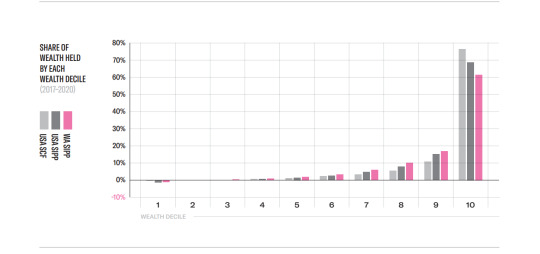
Overall, the three distributions look similar. In each, the bottom half of the distribution owns 1 to 2 percent of the wealth while the top half of the distribution owns 98 to 99 percent of the wealth. In the scf, the top 10 percent of US families hold 76 percent of the wealth while, in the sipp, the top 10 percent of US households hold 69 percent of the wealth and the top 10 percent of WA households hold 62 percent of the wealth.
This divergence is consistent with the fact that the sipp topcodes its wealth variables and does not get as much participation from very wealthy households as the scf does. The two figures may also differ because the scf family unit is not defined the same way that the sipp household unit is defined.
Here is another visualization of wealth inequality in WA using the sipp, graphed as a proportion plot.
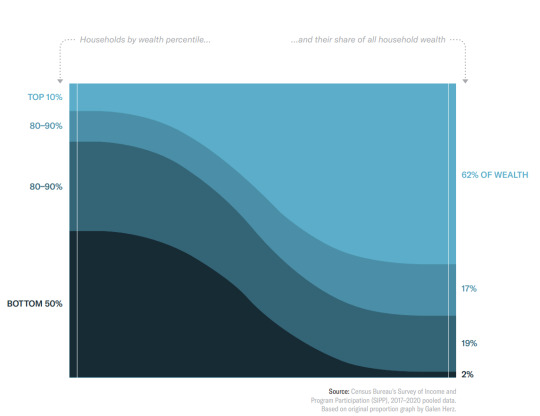
One way to partially overcome sipp’s limitations when it comes to reporting the information of the very wealthy is to add information from lists of the wealthiest Americans, such as the Forbes Billionaires List. Adding the Washingtonian billionaires included in the Forbes list increases the wealth share of the top 10 percent of WA households from 62 percent to 66 percent.

This modification helps bring the wealth distribution closer in line with reality, but the resulting distribution still likely understates the percentage of wealth held at the top. For the remaining analysis, we will only use the data contained in the pooled 2017–2020 sipp. Rather than try to partially correct for its understatement of top wealth by adding in a handful of billionaires or imputing higher wealth levels from the scf, we think it is clearer to simply note that the sipp has limitations when it comes to accurately reporting wealth at the top end of the distribution and to ask readers to incorporate that fact into their interpretation of the following sipp statistics.


The SCF assigns assets and liabilities to families not persons. So, for example, in the case of a married couple with two children that owns a home, the value of that home is assigned to the family as a whole, not to one or the other spouse or the children. The demographic characteristics of each family, and thus the demographic characteristics of the wealth they own, are derived from the information of the reference person in the household. So, if the reference person in the above homeowning family is a Black, college-educated, 35-yearold man, the value of the home ends up characterized as Black wealth, college-educated wealth, millennial wealth, and male wealth, even if other members of the family unit have different demographic characteristics.

Unlike the scf, the sipp assigns assets and liabilities to persons, with household wealth being the aggregate wealth of the persons of each household. When assets and liabilities are owned jointly by multiple people, as in a family, sipp assigns their values fractionally to each of the joint owners. Thus, in the example above, if the Black, college-educated, 35-year-old, male homeowner is married, half of the home’s value is assigned to him, while the other half is assigned to his spouse. This means that, if his spouse has a different race, age, educational background, or gender, those demographic characteristics will show up as owning half of the value of the home. Because wealth is almost always analyzed on the household or family level, person-level distributions of wealth are rarely reported, even by researchers who use the sipp data. But the person-level distribution is also interesting and so we will include that distribution alongside the household-level distribution in this analysis.
In the following graph, we can see the difference between the person-level, adult-level, and household-level distribution of wealth in WA state over this period.

The adult-level distribution is more unequal than the household-level distribution and the person-level distribution, which includes the wealth of children, is more unequal than adult-level distribution.
The table below shows the wealth level of these three distributions at various wealth percentiles.
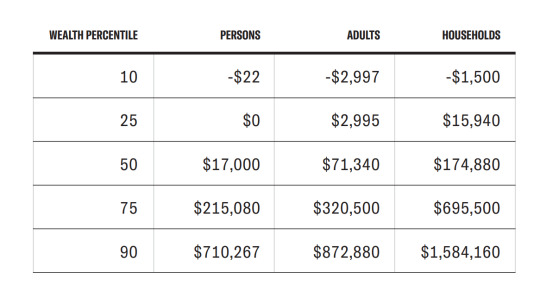
Across all persons, including children, the median wealth is $17,000. Across adults, the median wealth is $71,340. Across households, the median wealth is $174,880.
Race And Class
When comparing differences in wealth across race, it is common to look at the gap between mean and median wealth. The following table sums up these gaps for the person-level, adult-level, and household-level distribution in Washington.

On all measures, Black and Latino people have far less wealth than White people have. However, because White people are far more numerous in Washington than Black or Latino people are, the bottom of the wealth distribution still primarily consists of White people. This is true whether looking at the person-level, adult-level, or household-level distributions.
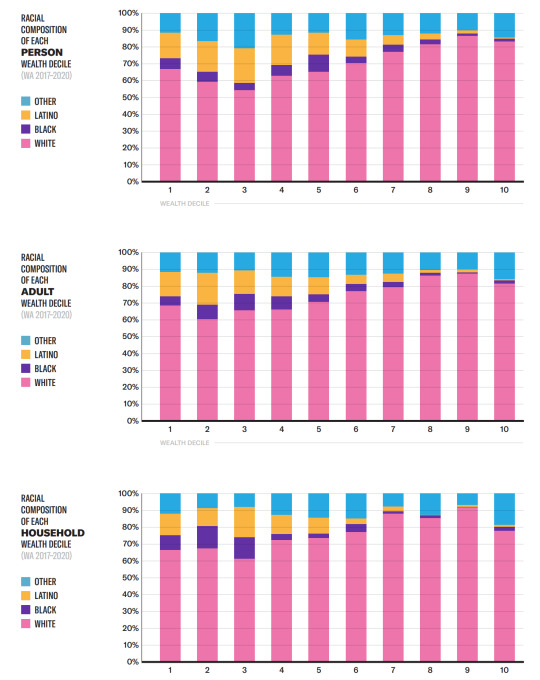

(Continue Reading)
#politics#the left#progressive#progressive movement#democratic socialism#socialism#peoples policy project#economics
26 notes
·
View notes
Text
Recruiting skilled developers through job boards can make a lot of difference in developing tech teams. However, navigating job boards to attract developers is not that easy. It requires good strategic planning and knowing what works best to attract top talents. With the right approach, you can access a global pool of highly qualified developers on job boards. Here are key factors to consider when using job boards for developer recruitment. Crafting an Attractive Job Description A good job description clearly states precisely what a candidate needs to fulfill all the requirements. Job descriptions highlight the developer's various responsibilities and the skills that would appeal to the developer. This should not be a generalization to parrot what becomes standard; rather, it should highlight how that developer's contribution will impact the whole company's success. Developers like to know that what they do fits into the whole. Be explicit about salary, remote working, and other perquisites that separate you from the rest. Many developers are more interested in flexibility, development opportunities, and work-life balance than traditional perks. Providing clear and straightforward information will help you reduce the pool of unqualified candidates and invite those who align with your company values. A checklist for hiring software developers can make recruitment easier. Career growth opportunities and the projects they will work on are also strong selling points. Highlighting Company Culture and Tech Stack Developers invest most of their working hours in the organization to dig into an environment that complements their values and interests. Presenting your culture and tech stack in your job post goes a long way in attracting the right talent. Share insights into your work style, team structure, and collaborative processes. Developers seek companies that inspire innovative thoughts, promise career growth, and welcome open-source contributions. Clearly outlining your tech stack will give developers insight into whether their skill set would work in your company. Cutting-edge technology or new skill training gives you the advantage of attracting developers. You can also share testimonials from existing team members or a day-in-the-life view, giving the candidates an immersive experience. Select the Right Job Board Not all job boards are created equal for developers. Choosing the right one ensures reaching the right person for the right job. Various job boards target different expertise levels; Turing and Topcoder offer work for highly skilled developers, whereas one might look at Upwork and Fiverr freelance positions. Knowing where your ideal candidates look will hugely impact the quality of applicants you get. Geographic preference also determines the choice of a job board. If remote developers are on your list of recruits, check out the global job boards. If you wish to hire local talent, local job boards may serve your purpose well. You must match the channels you're hiring from with the candidates you seek to have a higher chance of accomplishing desired outcomes. Multilingual job boards can take this a step further for global companies. Keywords and SEO Optimization Most job boards will use search algorithms that prioritize optimized job listings. Including relevant keywords in your job title and description makes them much easier to find. Research into the standard terms that developers tend to search based on their specific role, like "React Developer," "Python Engineer," and "Full-Stack Developer." A clearly articulated job listing is likely to attract an ideal candidate. Trying out keyword variations and using synonyms will enhance your searchability. Efficient Candidate Screening Job boards will be a source of many applications, so an efficient screening process is necessary. Using an ATS will allow for the scanning of CVs, facilitating further filtering of the skilled candidates from the application list.
Depending on the pre-screening question related to the skill sets and experience, lessening the pool interests many job boards since it grants them time to check out some screening tools. Additionally, introducing a few very short ice-breaking interviews would help gauge cultural fit as a starter, thus allowing for the progression of only the serious and most capable candidates onward. Then, artificial intelligence will screen resumes, which would streamline the process. Connect with Passive Candidates Many developers on job postings are not actively searching for jobs but are flexible at the right opportunity. Connecting with passive candidates builds a larger talent pool. You should consider direct messaging developers whose bios tick boxes for you. Personalization is key. A personalized message about why this opportunity is different can spark some interest. Building a short rapport, even with those not actively looking at jobs, opens up the door for later opportunities. Maintaining a pipeline of candidates can add efficiency to future hiring cycles. Engaging talent in developers' communities and online forums also builds engagement. Offering Competitive Salary The demand for developers is so high that salaries are crucial for attracting talent. Job postings that fail to include a salary range usually receive fewer applications. Research the market rates for the location and position and offer a fair and desirable package. Adding bonuses, work-from-home options, and training stipends will make your offer more attractive. Salary expectation transparency avoids wasting time on misfit candidates while instilling a sense of trust. It also helps avoid any potential roadblocks in negotiations later in the hiring process. Ensuring a Smooth Application Process Long or complicated application questions can discourage developers from applying, while a streamlined process would produce better-quality applications. Do not ask people to fill in endless forms or repeat the same information that is present on resumes or LinkedIn profiles. Keeping applications short and sweet minimizes the chance of discouraging a candidate from applying altogether. Allowing developers to substitute long application forms with GitHub links or coding samples could give a true insight into their potential, with a flavor of engagement in the process. Replying Quickly Speed of communication is important to keeping applicants engaged. Since many developers get more than one offer, not responding fast could cost you the chance to attract top talent. Quickly acknowledge applications and give expectations for the next steps. Even if a candidate asks for a decision more than once and is ultimately not selected, send them a courteous response to leave a positive impression. Setting up automated responses and scheduling tools for communication can help maintain efficiency. Informing candidates throughout the process will create a professional and respectful recruitment experience. Effectively Assessing Technical Skills Evaluating a developer's technical competencies is essential to the hiring process. However, conventional coding tests can occasionally seem detached from actual job requirements. Rather than relying on standard algorithm challenges, it may be beneficial to implement task-based evaluations that mirror real responsibilities encountered in the role. Assigning take-home coding tasks or conducting live coding sessions provide more precise insights into a candidate's problem-solving methods. Permitting developers to utilize their preferred tools and work environments during assessments fosters a more authentic and equitable evaluation of their capabilities. Endnote To effectively leverage job boards, it is essential to blend strategy with optimization and engagement efforts. Organizations can attract outstanding developers who share their objectives by carefully choosing appropriate platforms, crafting engaging job advertisements, and simplifying the hiring processes.
Persistent refinement of recruitment strategies using data analysis and feedback ensures sustained success in forming a robust and skilled technology team.
0 notes
Text
Week 12: Crowd sourcing in times of crisis
Social media news outlets, citizen journalism, or even using GPS applications such as Waze to head towards your favourite destination. These are but the many examples of crowd sourcing, However, do we really understand how it's really used when it's needed? In my final posting for my mini Tumblr blog adventure, let's take a look at what crowd sourcing really is and how it's used in times of crisis. 🏃

The simple definition of crowdsourcing can be understood as Hargrave (2022) defines it as the gathering of information from large groups of user. With the introduction of technology, a primary example of how crowd sourcing is useful would be the implementation of it during the crisis of Covid-19. Studies by Vermicelli, Cricelli, and Grimaldi (2020) notes how effective of a strategy it is to harness the power of online communities and distribute them globally across various domains by offering accessible, and rapid answers to solutions. The authors further note the usage of initiatives such as TopCoder, Openinnovability, NineSigma, etc are great crowdsourcing platforms providing insights for users to keep them engage and raise awareness about the ongoing issues related to Covid-19.

Other research by Riccardi (2016) suggests that crowdsourcing provides a sense of control for victims during crisis management. The author explained that if a person were affected by a certain incident, they would likely contact disaster managers or emergency services to update them about their current situation whether in terms of safety, food shortages, water and fire damages, etc through establishing it as a coping mechanism by "controlling" the situation. In a summary, the term crowdsourcing not only applies traditionally but digitally as well. Recent examples of Covid-19 highlight it's importance as initiatives were created with a sole purpose of gathering online data and help victims to actively engage with one another to keep their spirits high. While keeping a cool head is always a good thing we understand that thanks to crowdsourcing, a sense of control is there as victims use it for a coping mechanism during times of crisis. On that note, my mini Tumblr journey has come to an end. I hope everyone had a blast reading through my discussions, and I can't wait to what new adventures await! 💪 References Hargrave, M. (2022). Crowdsourcing: Definition, How It Works, Types, and Examples. Investopedia. https://www.investopedia.com/terms/c/crowdsourcing.asp Riccardi, M. T. (2016). The power of crowdsourcing in disaster response operations. International Journal of Disaster Risk Reduction, 20, 123–128. https://doi.org/10.1016/j.ijdrr.2016.11.001 Vermicelli, S., Cricelli, L., & Grimaldi, M. (2020). How can crowdsourcing help tackle the COVID���19 pandemic? An explorative overview of innovative collaborative practices. R&D Management, 51(2). https://doi.org/10.1111/radm.12443
0 notes
Text
5 Free Programming Learning Portals: Unlocking Free Access to Top - Notch Coding Skills
For software developers, maintaining a competitive level of programming is very necessary. By solving different types of programming difficulties and facing different types of programming challenges, you will not only become a master in handling problems, but also learn more and more new algorithms and become better and better. can.
Below are 5 quality programming sites that will help you improve your programming skills, prepare for technical interviews, and advance your professional development.
1.TopCoder TopCoder is an online platform that hosts competitive programming and software development contests. Programmers and software engineers can tackle various technical challenges and propose solutions. Competitive programming competitions on algorithms and data structures are held regularly. Programmers design efficient algorithms for a given problem and aim to find the optimal solution.
2.HackerRank HackerRank is an online platform aimed at improving programming skills and evaluating technical skills. There are also plenty of questions related to algorithms and data structures. You can try various programming tasks in a real coding environment. Problems are categorized by difficulty level, and problems are offered at a wide range of levels, from beginner to advanced.
3.GeeksforGeek GeeksforGeeks (GfG) is full of great articles and code solutions. It also offers competitive programming problems and contests and is widely used as a platform for programmers to improve their skills. If you’re preparing for a software engineering interview, you can also use this site to prepare and review more difficult algorithmic questions.
4.Coderbyte Coderbyte contains programming problems of various difficulty levels. These problems cover a variety of topics, from basic algorithms to data structures, string manipulation, and more. Additionally, coding challenges are held regularly. Participants must work on a given task and solve it within a time limit.
5.LeetCode LeetCode is a website aimed at improving programming skills and preparing for technical interviews. Different types of problems are offered, including data structures, algorithms, and system design. These questions are often asked in interviews at real tech companies. Therefore, by solving questions on LeetCode, you can prepare for the actual interview.
Programming is a profession that requires constant learning. Fortunately, in the age of the Internet, we can find a wealth of knowledge and learn constantly. Don’t be like me and say, “Stock never stops and learning never begins”.
0 notes
Text
How to Make Money with Programming: 9 Proven Ways to Earn from Your Coding Skills – Infographic
Programming isn’t just a skill, it’s a passport to countless income opportunities. Whether you’re a beginner or a seasoned developer, there are many ways to turn your coding knowledge into a reliable stream of income.
In this blog post infographic, we’ll explore nine effective ways to make money with programming, from starting a blog to developing games and selling online courses.

Download Infographic
1. Blogging
If you enjoy writing and have a passion for coding, blogging can be a fantastic way to earn money. Starting a programming blog allows you to share tutorials, code snippets, solutions to technical problems, or industry news. Over time, as your blog gains traffic, you can monetise it through:
Google AdSense
Affiliate Marketing (promote tools like GitHub Copilot, hosting providers, or IDEs)
Sponsored Posts
Email List Marketing
Choose a specific niche like Python automation, web development, or data science to attract a targeted audience. The more value you provide, the more loyal readers and passive income you can build.
2. Sell Books
Programmers who can write clearly and teach effectively often find success in self-publishing. Writing an eBook or paperback on a specific programming language, framework, or topic can generate steady income. You could publish:
Beginner guides (e.g. “Learn Python in 30 Days”)
Advanced problem-solving books
Interview preparation guides
You can sell books on platforms like Amazon Kindle Direct Publishing, Gumroad, or your own website. Add bonus material like source code or video content to increase value.
3. Web/App Development
One of the most straightforward and lucrative ways to make money with programming is by developing websites or mobile apps. Businesses everywhere need online presence and custom solutions. You can:
Build websites using WordPress, React, or Laravel
Develop mobile apps using Flutter or React Native
Offer eCommerce development (e.g. Shopify or WooCommerce)
You can sell your services to local businesses, startup founders, or online clients. Alternatively, create your own app or SaaS (Software as a service) and monetise it through subscriptions or ads.
4. YouTube Tutorials
YouTube is a powerful platform for programmers looking to build an audience and generate income. If you’re good at explaining concepts, start a programming channel with:
Coding tutorials (e.g. “Build a Todo App in JavaScript”)
Explainer videos (e.g. “What is an API?”)
Career advice and learning paths
You can earn money through YouTube ad revenue, channel memberships, sponsored videos, and affiliate links. Once your audience grows, you can also use your channel to promote your own products, like courses or software.
5. Freelancing
Freelancing offers flexibility and the ability to earn while working on a wide variety of projects. Platforms like:
Upwork
Freelancer
Fiverr
Toptal
…connect you with clients looking for developers. Whether it’s bug fixes, full-stack development, automation scripts, or WordPress setup, there’s always demand. To succeed, create a strong portfolio, offer competitive pricing, and deliver great results to gain repeat clients and referrals.
6. Games Development
If you’re passionate about gaming and have strong programming skills, consider game development. Platforms like Unity (C#) or Unreal Engine (C++) make it accessible to solo developers. You can:
Create indie games and publish them on Steam or itch.io
Build mobile games and monetise via ads or in-app purchases
Sell game assets, templates, or source code
Some developers also earn by creating tutorials, documentation, or toolkits that help other game developers.
7. Competitions
Coding competitions and hackathons are not just fun, they can be profitable too. Websites like:
HackerRank
Codeforces
TopCoder
Kaggle (for data science)
…often have prize money or sponsorship opportunities. Many companies also host hackathons and innovation challenges where winners receive cash, job offers, or equity. Even if you don’t win, competitions sharpen your skills and can improve your resume or portfolio.
8. Sell Software
Have a great idea for a tool that solves a problem? Package it as software and sell it! This could include:
SaaS tools (e.g. CRM for freelancers)
Developer tools (e.g. code snippet managers)
Desktop apps (e.g. productivity tools)
Browser extensions
You can monetise through one-time purchases, monthly subscriptions, or freemium models with paid upgrades. Promote your product through your blog, social media, or YouTube channel to build traction.
9. Sell Courses
Online learning is booming, and if you’re an expert in a topic, you can create and sell your own programming course. Platforms like:
Udemy
Teachable
Gumroad
Skillshare
…allow you to host and sell your courses to a global audience. Courses could focus on specific programming languages, frameworks, or skills like API development, data analysis, or building real-world apps.
High-quality video content, practical projects, and community support (e.g. Discord or Facebook group) will help you stand out and keep your students engaged.
Conclusion
Programming is one of the most versatile and valuable skills you can have in today’s economy. Whether you would like to work for yourself or build a side hustle, there are many ways to make money with coding, from sharing your knowledge through blogs or courses to building products and solutions for clients or the marketplace.
The key is to start with one path, stay consistent, and keep learning. As you grow in experience and confidence, you can diversify your income by combining multiple strategies. For example, many successful developers run blogs, YouTube channels, and sell software or courses all at once.
So pick your starting point, and begin turning your coding skills into real-world income!
0 notes
Text






People who find topcoder better then Google people who find topcoder suspicious for passport programs and modern slavery when the a.i. does that
0 notes
Text
Top Tips for Excelling in Your MCA Program

Are you an MCA (Master of Computer Applications) student aiming to enhance your programming skills? Whether you’re a beginner or have some experience, developing strong programming skills is essential for a successful career in MCA. In this guide, we’ll share practical tips and strategies to help you excel. Whether you're considering enrolling in an MCA coaching institute in yamuna vihar , this guide will help you make an informed decision.
1. Focus on the Basics
Before diving into complex topics, ensure you have a strong understanding of basic programming concepts. This includes:
Data types and structures
Control structures (loops, conditionals)
Functions and procedures
Object-oriented programming principles
A solid foundation will make it easier to grasp advanced topics later.
2. Practice Regularly
Consistent practice is key to becoming proficient in programming. Set aside time each day to write code. You can start with small exercises and gradually move on to more complex projects. Websites like LeetCode, HackerRank, and CodeSignal offer a variety of coding challenges to help you practice.
3. Work on Projects
Applying your knowledge to real-world projects is one of the best ways to learn. Projects allow you to see how different programming concepts work together. Try to:
Build simple applications: Start with basic projects like calculators, to-do lists, or simple games.
Contribute to open-source projects: This will give you experience working on larger codebases and collaborating with other developers.
Create a portfolio: Showcase your projects on platforms like GitHub to impress potential employers.
4. Join Study Groups
Studying with peers can provide different perspectives and help you solve problems more effectively. Look for study groups at your MCA academy in Uttam Nagar. These groups can offer support, share resources, and motivate you to keep learning.
5. Take Advantage of Online Resources
There are numerous online resources available to help you learn programming. Some of the best include:
Online courses: Websites like Coursera, Udemy, and edX offer courses on various programming languages and concepts.
Tutorials: Follow step-by-step tutorials on YouTube or programming blogs to learn new skills.
Documentation: Familiarize yourself with the official documentation of the programming languages and tools you use.
6. Seek Guidance from Experts
Enrolling in an MCA training institutes in Yamuna Vihar can provide you with access to experienced instructors who can guide you through difficult concepts and offer valuable feedback on your work.
7. Participate in Coding Competitions
Coding competitions are a fun way to test your skills and learn from others. Platforms like CodeChef, TopCoder, and Google Code Jam host regular contests. Participating in these can help you improve your problem-solving abilities and gain recognition in the programming community.
8. Read Programming Books
Books can offer in-depth knowledge and different perspectives on programming. Some recommended reads for MCA students include:
"Clean Code" by Robert C. Martin: Learn about writing clean, readable, and maintainable code.
"The Pragmatic Programmer" by Andrew Hunt and David Thomas: Gain practical advice on becoming a better programmer.
"Introduction to Algorithms" by Thomas H. Cormen, Charles E. Leiserson, Ronald L. Rivest, and Clifford Stein: Understand fundamental algorithms and data structures.
9. Stay Updated with Industry Trends
The field of computer science is constantly evolving. Stay updated with the latest trends and technologies by:
Reading tech blogs and websites: Follow sites like TechCrunch, Hacker News, and Stack Overflow.
Attending webinars and workshops: Many organizations offer free or low-cost online events.
Joining professional networks: Platforms like LinkedIn can help you connect with industry professionals and stay informed about job opportunities.
10. Don't Be Afraid to Fail
Learning to program involves making mistakes and encountering challenges. Don’t be discouraged by failures. Instead, view them as opportunities to learn and grow. The more you practice and experiment, the better you will become.
By following these tips, you can develop strong programming skills during your MCA program and set yourself up for a successful career in computers. Whether you’re studying at an MCA course in Uttam Nagar, the key is to stay dedicated, keep practicing, and never stop learning. Happy coding!
0 notes
Text
How to Prepare for Interviews for Senior Software Engineer Jobs
“Crack the Code: Mastering Your Interview for Senior Software Engineer Jobs”

Landing a position in Senior Software Engineer Jobs is no small feat. It requires not only exceptional technical skills but also the ability to demonstrate leadership, problem-solving prowess, and a deep understanding of software development principles. If you’re aiming to secure a role in Software Engineer Jobs at the senior level, you need a strategic approach to your interview preparation. Here’s a comprehensive guide to help you ace your interviews and land that dream job!
1. Understand the Role and Expectations
Before diving into preparation, it's crucial to understand what makes a great Senior Software Engineer. Here’s what recruiters typically look for:
Technical Expertise: Deep knowledge in programming languages (Java, Python, C++), algorithms, and data structures.
System Design Skills: Ability to design scalable, reliable, and efficient systems.
Leadership and Mentorship: Proven track record of leading teams, mentoring junior engineers, and driving projects to completion.
Problem-Solving Ability: Strong analytical skills and a knack for tackling complex technical challenges.
2. Revise Core Technical Skills
As a Senior Software Engineer, you must demonstrate a strong grasp of technical fundamentals. Here’s a focused approach:
Advanced Algorithms and Data Structures: Brush up on algorithms (sorting, searching, dynamic programming) and data structures (trees, graphs, heaps). Practice problems on platforms like LeetCode, HackerRank, or CodeSignal.
System Design: Master system design principles. Study case studies and practice designing scalable systems. Key areas include load balancing, caching, database sharding, and microservices architecture. Resources like Grokking the System Design Interview can be invaluable.
3. Hands-On Coding and Problem Solving
Coding interviews are a critical component of Senior Software Engineer Jobs. Here’s how to excel:
Mock Interviews: Participate in mock interviews with peers or use platforms like Pramp or Interviewing.io to simulate real interview scenarios. This helps you get comfortable with the format and receive feedback.
Coding Practice: Work on coding challenges regularly. Focus on solving problems that are likely to be asked in senior-level interviews. Use tools like LeetCode, Codeforces, or TopCoder.
4. Deep Dive into Technologies and Tools
Senior roles often require expertise in specific technologies. Here’s a breakdown:
Programming Languages: Ensure you are proficient in the languages commonly used in the industry. For instance, Java, Python, C++, or JavaScript.
Development Tools and Frameworks: Be well-versed in popular frameworks and tools relevant to your field. This might include Spring Boot for Java, Django for Python, or React for JavaScript.
DevOps and CI/CD: Familiarize yourself with DevOps practices, CI/CD pipelines, and tools like Jenkins, Docker, Kubernetes, or Terraform. Understanding these can give you an edge.
5. Showcase Your Problem-Solving Skills
Problem-solving is a core competency for senior roles. Here’s how to showcase it:
Real-World Problems: Prepare to discuss past projects and problems you’ve solved. Highlight your role, the challenges faced, and the impact of your solutions.
Technical Deep Dives: Be ready to dive deep into technical discussions. Explain your thought process, decisions, and trade-offs. Use the STAR method (Situation, Task, Action, Result) to structure your answers.
6. Prepare for Behavioral and Situational Questions
Senior positions often come with leadership and behavioral questions. Here’s how to prepare:
Leadership Experience: Be ready to discuss your experience in leading teams, mentoring peers, and driving projects. Use specific examples to demonstrate your leadership style and achievements.
Problem-Solving Scenarios: Expect situational questions that test your decision-making and problem-solving skills. Practice questions like, “How do you handle conflicts within your team?” or “Describe a time when you had to solve a complex technical problem.”
7. Demonstrate Your Soft Skills
Soft skills are crucial for senior roles. Here’s how to highlight them:
Communication Skills: Clearly articulate your thoughts and ideas. Practice explaining complex technical concepts to non-technical stakeholders.
Collaboration and Teamwork: Showcase your ability to work effectively in a team. Discuss your experience with cross-functional teams, code reviews, and collaborative projects.
8. Research the Company and Role
Understanding the company’s culture, products, and technologies is essential:
Company Research: Study the company’s website, recent projects, and news. Understand their tech stack, products, and market position.
Role-Specific Preparation: Review the job description carefully. Align your skills and experiences with the requirements. Prepare to discuss how you can contribute to their projects and goals.
9. Ask Insightful Questions
Asking thoughtful questions can set you apart:
About the Team: Inquire about the team structure, development processes, and current projects. Questions like, “What are the biggest challenges the team is facing?” or “How does the team handle code reviews?”
About Growth and Opportunities: Ask about career growth opportunities, learning and development programs, or future projects. Questions like, “What opportunities are there for professional development?” or “What are the next big projects the team is working on?”
10. Practice, Practice, Practice
The key to acing your interview is consistent practice:
Mock Interviews: Schedule regular mock interviews with peers or mentors. Use platforms like Interviewing.io or Pramp for real-time feedback.
Coding Practice: Dedicate time each day to coding practice. Solve problems on competitive coding sites and review your solutions.
Feedback Loop: Seek feedback on your coding and interview performance. Use this feedback to refine your approach and improve continuously.
0 notes
Text
Week 12
Crowd Sourcing in Times of Crisis
Crowdsourcing is a powerful tool to gather real-time information, ideas or services from a large group of people, especially from an online community. It is a decentralised network that grasps the collective intelligence and efforts of the public to address challenges that arise during emergencies such as natural disasters, pandemics, or political issues. For example, the Ushahidi Haiti Project collected approximately 40,000 independent reports, and within a few hours, nearly 4,000 unique events were mapped (Yang et al., 2014). This has shown crowdsourcing plays a crucial role in real-time gathering information and enabling people to share and update information simultaneously.
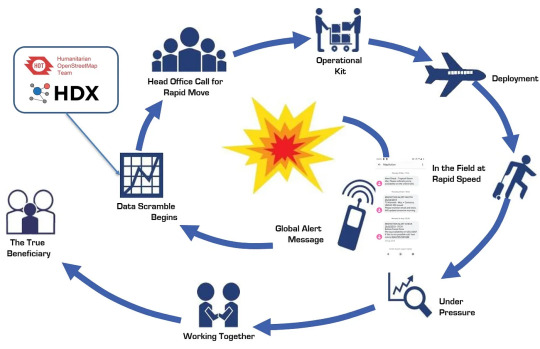
MapAction rapid response process.
Certainly, crowdsourcing is being utilised to help mobilise resources such as food, medical supplies, and volunteers. It allows diverse communities to collaborate and improve communication through online platforms. TopCoder, an online platform offering crowd-contest services, launched the Anti-Coronavirus Hackathon, an ideation challenge aimed at generating ideas from its community to assist people, governments, and organisations during the coronavirus outbreak (Vermicelli et al., 2020). Engaging the community in crisis response efforts fosters a sense of ownership and empowerment. Additionally, crowdsourcing encourages society to take the initiative to be involved in disaster response and recovery. For instance, the "Humanitarian OpenStreetMap Team" entitles volunteers to create and update maps in areas affected by disasters, providing critical information for responders.

The accuracy of data, users’ privacy, and the digital divide have become the concerns of society. There is controversy about the compromise between the speed of information gathering and the accuracy of data. In crises, quick decisions are often necessary, but relying on unsubstantiated crowdsourced data can lead to misinformation and ineffective responses. In order to ensure the reliability of crowdsourced information, verification mechanisms and partnerships with trusted entities can help alleviate the risk of misinformation. Crowdsourcing in times of crisis offers multiple advantages, from rapid data collection to diverse problem-solving. However, it also presents challenges that integrate with data quality, privacy, and coordination. As technology evolves gradually, the rapid expansion of crowdsourcing makes it essential to confront these obstacles and leverage the collective strengths of the crowd in a responsible and ethical manner.
References:
Penson, S. (2021, December 13). Mapping for Humanitarian Response 2019 MapAction and Humanitarian OpenStreetMap Team. Medium. https://medium.com/@steve.penson/mapping-for-humanitarian-response-2019
Vermicelli, S., Cricelli, L., & Grimaldi, M. (2020). How can crowdsourcing help tackle The COVID‐19 pandemic? An explorative overview of innovative collaborative practices. R & D Management, 51(2), 183–194. https://doi.org/10.1111/radm.12443
Yang, D., Zhang, D., Frank, K., Robertson, P., Jennings, E., Roddy, M., & Lichtenstern, M. (2014). Providing real-time assistance in disaster relief by leveraging crowdsourcing power.Personal and Ubiquitous Computing, 18(8), 20252034. https://doi.org/10.1007/s00779-014 0758-3
0 notes
Text
How to Hire App Developers India in 2023?
With increasing smartphone usage, more businesses are developing mobile applications for their users. This is where most people spend their maximum time. It is also the channel where you can connect and communicate with the users.
To build successful apps, you must hire app developers India who can offer the rightful solutions and services. They can translate your idea into a solution that can draw more people and enhance visibility.
However, finding the right developer can be slightly difficult. You might need to look at the top steps that include defining the scope and identifying the developer requirements.
We have curated a few steps that are crucial in finding the right developer to support your vision.
1. Start with determining the budget for the application development project. If you have a stringent amount you can spend or a strict costing, you must draw that effectively. Once you have the budget, creating the budget plan is important. This is where you suggest how you aim to spend the amount you have with you. For instance, if you want to build an application that can be distributed across platforms, you must choose the approach in the budget plan. Can your budget support hiring both iOS and android developers. How do you plan to hire mobile app developers in India with the budget? Do you think a freelancer is appropriate for the budget plan you have? Similarly, what amount would you spend on hiring the developers?
2. Once you have a budget plan, you would know your hiring costs and app development needs in detail. You would have prioritized your spending in detail. Now, you must start looking for the developer or development company according to the budget plan. In the detailed plan check how much you can spend on an experienced company. Similarly, find out what type of developer you would need for the particular project. Do you think a freelancer can handle the scope and detail of the project? Do you think an expert will be available in your budget? You can look into the communities like Topcoder and NewAppIdea to help you determine the right developers for your business. you must also look at top sites like UpWork for this purpose
3. When you hire app developers India, you must also have a proper assessment and vetting process. If you cannot define the process, you might partner with someone who is not fully capable of translating your ideas into the right solutions. Always look at all the assessment frameworks that support your vision. It is also important to look for a developer with the right expertise and niche understanding. Check their portfolio and development styles in detail before proceeding with the match.
4. An in-person consultation or meeting with the developer is an important part of the job. You must connect with them and interview them to understand the requirements. It is important to check with them about the process, their commitment and communication protocol before moving forward.
Make sure to sign a detailed contract and an NDA with the company before you hire mobile app developers in India.
0 notes
Text
5 recommended learning sites where you can learn programming for free
For software developers, maintaining a competitive level of programming is very necessary. By solving different types of programming difficulties and facing different types of programming challenges, you will not only become a master in handling problems, but also learn more and more new algorithms and become better and better. can.
Below are 5 quality programming sites that will help you improve your programming skills, prepare for technical interviews, and advance your professional development.
1.TopCoder
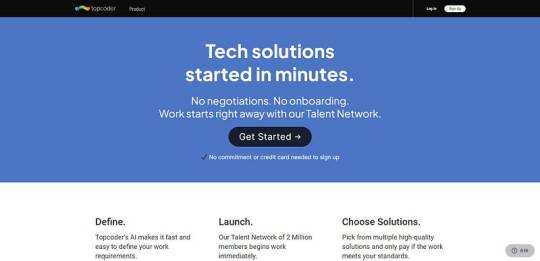
2.HackerRank

3.GeeksforGeek
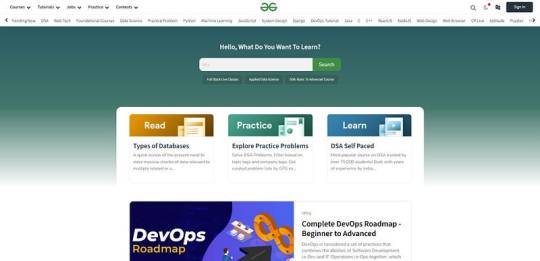
4.Coderbyte
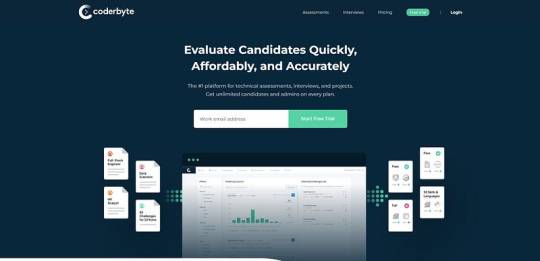
5.LeetCode
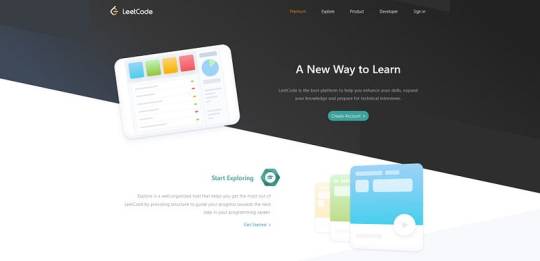
Programming is a profession that requires constant learning. Fortunately, in the age of the Internet, we can find a wealth of knowledge and learn constantly. Don’t be like me and say, “Stock never stops and learning never begins”.
1 note
·
View note
Text

It's been a while since I've sat down and organized these.
Behold: the common paper silica gel packet. They tend to contain tiny orbs of silica. I have about 250 because you can find these in most bags and shoeboxes.

The second most common are this blue kind - some are a waxed paper and others are more of a fabric. Some contain orbs, some contain white powder, and some contain brown powder. I have 82.

Topcod makes a bigger version of them in the wax paper with white and brown powder mixed. I have 36 of these.

There are a lot of variations, I wish I had another "green desiccant" one to open and see if the orbs are really green. The languages featured on each pack give you a sense of where or for who it was manufactured. I have 55 various paper packets.

Plastic ones are very uncommon, and I'm not entirely sure how they work. The brown substance here is quite different from what's in more common packs, so I don't think it's silica. Not sure what the O-Buster oxygen absorber is made of either. The purple and turquoise one has an extremely fine powder inside.

This is the only one I have that says it's natural, plastic-free, and biodegradable. Very rare.

So that was 9 plastic, and then I have 30 other various cloth ones. Which brings my grand total to 462.
I started collecting these packets with the intention of using them for art (this was at least 6 years ago), but now I just collect. They serve no purpose whatsoever. My family brings them to me when they find them, and I keep them in ziploc bags. I think I like them too much as three dimensional objects to lock them into a frame or book or something.
1 like and I'll post pics of my silica packet collection
11 notes
·
View notes
Text
Tips for Success in Your MCA Journey

Are you an MCA (Master of Computer Applications) student aiming to enhance your programming skills? Whether you’re a beginner or have some experience, developing strong programming skills is essential for a successful career in MCA. In this guide, we’ll share practical tips and strategies to help you excel. Whether you're considering enrolling in an MCA coaching institute in yamuna vihar , this guide will help you make an informed decision.
1. Focus on the Basics
Before diving into complex topics, ensure you have a strong understanding of basic programming concepts. This includes:
Data types and structures
Control structures (loops, conditionals)
Functions and procedures
Object-oriented programming principles
A solid foundation will make it easier to grasp advanced topics later.
2. Practice Regularly
Consistent practice is key to becoming proficient in programming. Set aside time each day to write code. You can start with small exercises and gradually move on to more complex projects. Websites like LeetCode, HackerRank, and CodeSignal offer a variety of coding challenges to help you practice.
3. Work on Projects
Applying your knowledge to real-world projects is one of the best ways to learn. Projects allow you to see how different programming concepts work together. Try to:
Build simple applications: Start with basic projects like calculators, to-do lists, or simple games.
Contribute to open-source projects: This will give you experience working on larger codebases and collaborating with other developers.
Create a portfolio: Showcase your projects on platforms like GitHub to impress potential employers.
4. Join Study Groups
Studying with peers can provide different perspectives and help you solve problems more effectively. Look for study groups at your MCA academy in Uttam Nagar. These groups can offer support, share resources, and motivate you to keep learning.
5. Take Advantage of Online Resources
There are numerous online resources available to help you learn programming. Some of the best include:
Online courses: Websites like Coursera, Udemy, and edX offer courses on various programming languages and concepts.
Tutorials: Follow step-by-step tutorials on YouTube or programming blogs to learn new skills.
Documentation: Familiarize yourself with the official documentation of the programming languages and tools you use.
6. Seek Guidance from Experts
Enrolling in an MCA training institutes in Yamuna Vihar can provide you with access to experienced instructors who can guide you through difficult concepts and offer valuable feedback on your work.
7. Participate in Coding Competitions
Coding competitions are a fun way to test your skills and learn from others. Platforms like CodeChef, TopCoder, and Google Code Jam host regular contests. Participating in these can help you improve your problem-solving abilities and gain recognition in the programming community.
8. Read Programming Books
Books can offer in-depth knowledge and different perspectives on programming. Some recommended reads for MCA students include:
"Clean Code" by Robert C. Martin: Learn about writing clean, readable, and maintainable code.
"The Pragmatic Programmer" by Andrew Hunt and David Thomas: Gain practical advice on becoming a better programmer.
"Introduction to Algorithms" by Thomas H. Cormen, Charles E. Leiserson, Ronald L. Rivest, and Clifford Stein: Understand fundamental algorithms and data structures.
9. Stay Updated with Industry Trends
The field of computer science is constantly evolving. Stay updated with the latest trends and technologies by:
Reading tech blogs and websites: Follow sites like TechCrunch, Hacker News, and Stack Overflow.
Attending webinars and workshops: Many organizations offer free or low-cost online events.
Joining professional networks: Platforms like LinkedIn can help you connect with industry professionals and stay informed about job opportunities.
10. Don't Be Afraid to Fail
Learning to program involves making mistakes and encountering challenges. Don’t be discouraged by failures. Instead, view them as opportunities to learn and grow. The more you practice and experiment, the better you will become.
By following these tips, you can develop strong programming skills during your MCA program and set yourself up for a successful career in computers. Whether you’re studying at an MCA course in Uttam Nagar, the key is to stay dedicated, keep practicing, and never stop learning. Happy coding!
0 notes
Text
instagram
#linux#cyber#computerscience#technologies#programming#python#darkit#technews#programmerlife#anonymous#cybersecurity#kalilinux#technology#cybercrime#coding#programmer#malware#topcoder#ferrari#microsoft#lamborghini#billionaire#happywomensday#Instagram
2 notes
·
View notes
Text
i don't know if this is a serious question or not, but i'll reply as though it is, just because i feel like answering this and that if i rb my thoughts it could start an interesting discussion & could be useful to any starting compsci students ^^
the common rationale i've heard for people doing this (coding problems) is that it's supposed to help you practice:
problem recognition, and where the right data structures and algorithms fit in
gathering requirements for the problem
talking your way through the problem like you will in an interview
coding on a whiteboard or paper, not a computer (google interviews have you code on a whiteboard, for e.g.)
coming up with time and space complexity for your solutions
testing your solutions
personally for me it's also just quicker for me to work on, especially when i don't have the time or motivation to work on actual projects and i don't want to get rusty (also i get given coding problems for homework so i don't have a choice haha). i can work on different problems everyday and see what things i need to improve on, and then target those key areas
that said, i definitely agree that working on projects can be more useful for the programmer, especially for beginning ones. these target actual things you'd likely want to work on in your job (depending on what you want to do), and having to juggle and troubleshoot multiple problems is a good thing to have to experience, especially since any problems you encounter w/ projects are ones that you most likely need to know about so you can avoid it in the future
useful/relevant links (honestly more for my sake):
solving problems:
Algorithm Design Canvas
How To Find A Solution
How To Dissect A TopCoder Problem Statement
coding interview question videos:
IDeserve (88 videos)
Tushar Roy (5 playlists)
Nick White - LeetCode Solutions (187 Videos)
FisherCoder - LeetCode Solutions
challenge/practice sites:
LeetCode
HackerRank
TopCoder
Codeforces
Codility
CodeWars
Geeks for Geeks
AlgoExpert (created by google engineers)
Project Euler (very math focused, and not really suited for coding interviews)
projects:
100ProjectsofCode
Project Ideas & Solutions
"I Need Practice Programming": 49 Ideas for Game Clones to Code
10 Coding Projects for Beginners
13 Coding Projects and Programming Ideas for Beginners
More project ideas to improve your coding skills
Computer Science Projects
Programming Project Ideas: 22+ Top Side Projects for Software Engineers
DevProjects
App Ideas
13 Project Ideas for Intermediate Python Developers
42 Projects to Practice Programming Skills (this one's not for those just starting out, unless you're one of those people who like to jump off the deep end into the depths lmao. it's part of a challenge called #42SkillsChallenge)
leetcode
i dont get practicing by using leetcode over projects why cry over one small problem when you can cry over a dozen interwoven ones at the same time? i thought computer scientists liked efficiency
254 notes
·
View notes
Text

Coding has become a habit and the top coding trainees at Technical Hub has submitted multiple programs on different programming languages.
#TechnicalHub#technicalhubio#adityaengineeringcolleges#effectivetraining#getplaced#GetCertified#technology#tech#innovation#engineering#codemind#TOPCODER
0 notes